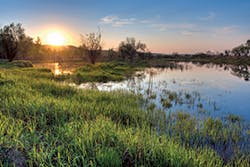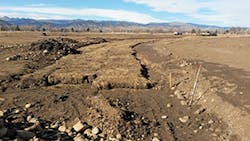Constructed Wetlands for Erosion Control and Stormwater Mitigation
Editor’s note: This article first appeared in the November-December 2015 issue of Erosion Control.
Many people think of wetlands as smelly, mosquito-ridden nuisances, but healthy wetlands provide habitat for birds, fish, amphibians, bats, and other insects that live on mosquitoes.
Wetlands are home to more than one-third of the United States’ threatened and endangered species, according to EPA. They buffer storm surges in coastal areas. They protect the edges of oceans, lakes, rivers, bays, and the smallest streams. Their vegetation holds soil in place, absorbs the energy of waves, and breaks up the flow of stream or river currents.
Editor's note: This article first appeared in the November-December 2015 issue of Erosion Control. Many people think of wetlands as smelly, mosquito-ridden nuisances, but healthy wetlands provide habitat for birds, fish, amphibians, bats, and other insects that live on mosquitoes. Wetlands are home to more than one-third of the United States’ threatened and endangered species, according to EPA. They buffer storm surges in coastal areas. They protect the edges of oceans, lakes, rivers, bays, and the smallest streams. Their vegetation holds soil in place, absorbs the energy of waves, and breaks up the flow of stream or river currents. [text_ad] They also trap snowmelt and stormwater runoff. Sediment in the water, and the nutrients and pollutants attached to the sediment, settle in the bottom, and cleaner water flows out. In fact, wetlands are so valuable that states are restoring them and mitigating for their loss by constructing new ones. “Constructed wetlands can be a lot of things and take a lot of different forms,” says David Whitney, a civil engineer and owner of EcoSolutions LLC in Westford, VT. “What they all have in common is that they all incorporate plants and they are all saturated with water for extended periods of time.” Many constructed wetlands are used as stormwater BMPs. They also might mitigate for land reclamation or the loss of protected habitats to development. While natural wetlands have a wide diversity of plants and animals that have evolved over long periods of time, wetlands constructed as stormwater BMPs have less diversity because it is simply not possible for designers to completely recreate natural wetlands with native plants, stone, and other materials. The plants are critical because they have adapted to the wetlands and filter stormwater well: “the workhorses of the plant world,” Whitney calls them. [text_ad use_post='27664'] “A constructed wetland made for stormwater treatment isn’t necessarily habitat restoration. It’s intended to be a repository for sediment, where in between storm events the contaminants associated with that sediment can be biologically broken down. We’re putting it right in line with a pollutant load. We want plants that will clarify the water.” When the sediment settles, so do the pollutants attached to it. They may include industrial and municipal waste, oil and grease, decaying plant and animal matter, and pesticides and fertilizer.They also trap snowmelt and stormwater runoff. Sediment in the water, and the nutrients and pollutants attached to the sediment, settle in the bottom, and cleaner water flows out.
In fact, wetlands are so valuable that states are restoring them and mitigating for their loss by constructing new ones.
“Constructed wetlands can be a lot of things and take a lot of different forms,” says David Whitney, a civil engineer and owner of EcoSolutions LLC in Westford, VT. “What they all have in common is that they all incorporate plants and they are all saturated with water for extended periods of time.”
Many constructed wetlands are used as stormwater BMPs. They also might mitigate for land reclamation or the loss of protected habitats to development.
While natural wetlands have a wide diversity of plants and animals that have evolved over long periods of time, wetlands constructed as stormwater BMPs have less diversity because it is simply not possible for designers to completely recreate natural wetlands with native plants, stone, and other materials. The plants are critical because they have adapted to the wetlands and filter stormwater well: “the workhorses of the plant world,” Whitney calls them.
“A constructed wetland made for stormwater treatment isn’t necessarily habitat restoration. It’s intended to be a repository for sediment, where in between storm events the contaminants associated with that sediment can be biologically broken down. We’re putting it right in line with a pollutant load. We want plants that will clarify the water.”
When the sediment settles, so do the pollutants attached to it. They may include industrial and municipal waste, oil and grease, decaying plant and animal matter, and pesticides and fertilizer.
Organic matter attached to the sediment is broken down by bacteria that consume the oxygen in the water, which results in an unhealthy aquatic environment, he says. However, well-chosen plants move oxygen from the air to the plants’ roots. The roots benefit from the oxygen, and bacteria, especially next to and in the roots, break down the pollutants into forms that are useful to the rest of the plant.
“If you can create this well-balanced environment, it’s very robust,” says Whitney. “Plants and animals adapt very well. They can survive under a very wide range of conditions.”

